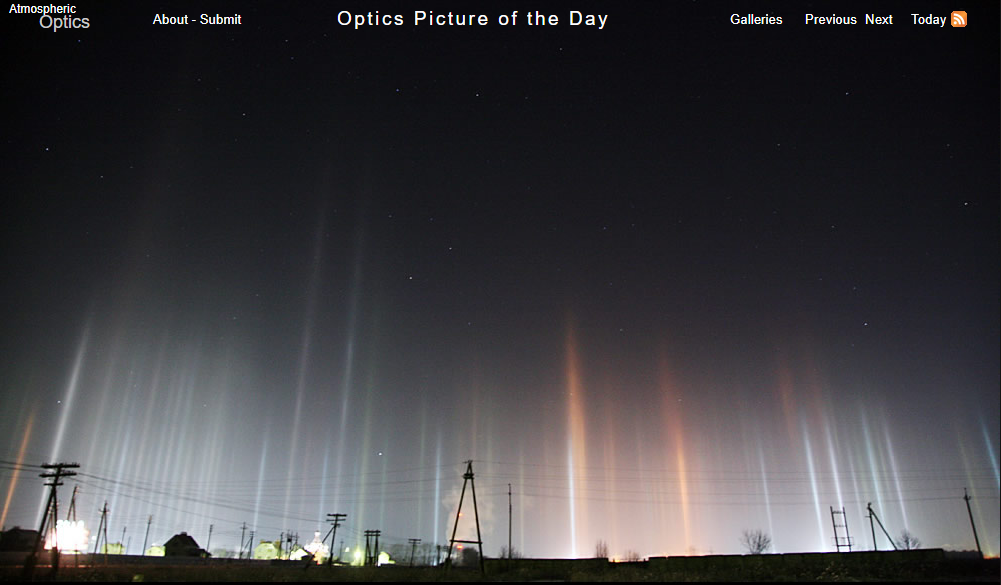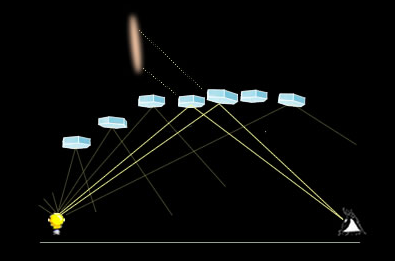Russian Pillars
Russian Pillars: A Mesmerizing Atmospheric Phenomenon
Atmospheric optics never ceases to amaze us with its captivating displays of light and color. One such phenomenon that continues to leave spectators in awe is the enchanting sight of Russian Pillars. These ethereal pillars of light, also known as light pillars, grace the night skies with their vertical columns of radiance, creating a surreal and magical ambiance.
What are Russian Pillars?
Russian Pillars are optical phenomena that occur when light from artificial sources, such as streetlights or buildings, is reflected by ice crystals suspended in the atmosphere. These ice crystals act as tiny mirrors, redirecting the light downwards and creating the illusion of vertical beams of light shooting up into the sky. The result is a breathtaking spectacle that can be observed in regions with extremely cold temperatures and high levels of atmospheric moisture.
The Science Behind the Magic
To understand the science behind Russian Pillars, we must delve into the intricate workings of light and ice crystals. When light encounters these tiny ice crystals, it undergoes a process called refraction. The light rays bend as they pass through the ice crystals, changing direction and dispersing into various colors. As the refracted light exits the ice crystals, it is reflected off their surfaces, creating the mesmerizing pillars of light that captivate our senses.
The Role of Temperature and Moisture
The formation of Russian Pillars relies heavily on specific atmospheric conditions. Extremely cold temperatures are essential for the formation of ice crystals in the air. These ice crystals can take various shapes, such as plates or columns, depending on the prevailing conditions. Additionally, a high level of atmospheric moisture is necessary to provide an ample supply of water vapor that can freeze into these crystals.
A Symphony of Colors
One of the most captivating aspects of Russian Pillars is the vibrant array of colors they exhibit. The ice crystals act as prisms, breaking down the white light into its component colors through dispersion. This dispersion causes the pillars to display a stunning spectrum of hues, ranging from reds and oranges to blues and purples. The result is a breathtaking tapestry of colors that paints the night sky with an otherworldly beauty.
Observing Russian Pillars
To witness the enchanting spectacle of Russian Pillars, one must venture to regions with the ideal atmospheric conditions. Locations with extremely cold temperatures and high levels of moisture, such as Ryazan in Russia, provide the perfect environment for the formation of these phenomena. When the conditions align, observers can marvel at the vertical columns of light stretching towards the heavens, casting an ethereal glow over the landscape.
Differentiating Russian Pillars from Similar Phenomena
While Russian Pillars may appear similar to other atmospheric optical phenomena, such as light pillars caused by natural sources like the Sun or Moon, there are subtle differences that set them apart. Russian Pillars are specifically formed by artificial light sources, such as streetlights or buildings, while natural light pillars originate from celestial bodies. Additionally, Russian Pillars tend to be more concentrated and vertical in nature, whereas natural light pillars can exhibit a more diffuse and horizontal appearance.
Capturing the Magic: Photography Tips
Photographing Russian Pillars can be a rewarding experience for avid photographers. To capture the essence of this captivating phenomenon, there are a few key tips to keep in mind:
- Use a tripod to ensure stability and avoid blurring.
- Experiment with different exposure settings to capture the vibrant colors and intricate details.
- Include interesting foreground elements to add depth and context to your images.
- Consider shooting during the "blue hour" when the sky has a deep blue hue, contrasting beautifully with the pillars of light.
- Explore different vantage points and angles to find unique perspectives that enhance the visual impact of the Russian Pillars.
The Magic of Russian Pillars Lives On
As we continue to explore the wonders of atmospheric optics, Russian Pillars remain a testament to the captivating beauty of our natural world. These vertical columns of light, created by the interplay between artificial sources and ice crystals, provide a visual spectacle that never fails to inspire awe. So, the next time you find yourself in a region with the ideal conditions, be sure to look up and witness the enchanting dance of Russian Pillars illuminating the night sky.

Russian Pillars ~ The stars compete with city lights reflected downwards by myriad ice crystals over Ryazan 110 miles southeast of Moscow. Imaged by Boris Dmitriev. ©Boris Dmitriev, shown with permission.

Note: this article has been automatically converted from the old site and may not appear as intended. You can find the original article here.
Reference Atmospheric Optics
If you use any of the definitions, information, or data presented on Atmospheric Optics, please copy the link or reference below to properly credit us as the reference source. Thank you!
-
<a href="https://atoptics.co.uk/blog/russian-pillars/">Russian Pillars</a>
-
"Russian Pillars". Atmospheric Optics. Accessed on November 21, 2024. https://atoptics.co.uk/blog/russian-pillars/.
-
"Russian Pillars". Atmospheric Optics, https://atoptics.co.uk/blog/russian-pillars/. Accessed 21 November, 2024
-
Russian Pillars. Atmospheric Optics. Retrieved from https://atoptics.co.uk/blog/russian-pillars/.